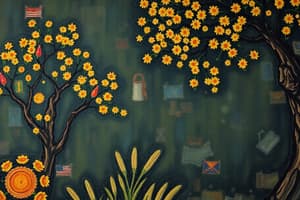Podcast
Questions and Answers
More than half of the world’s population is bilingual or multilingual.
More than half of the world’s population is bilingual or multilingual.
True (A)
Mr. Patel uses English exclusively at home with his family.
Mr. Patel uses English exclusively at home with his family.
False (B)
Vernacular languages have an official status and are standardized.
Vernacular languages have an official status and are standardized.
False (B)
Languages can be categorized based on their status and social functions.
Languages can be categorized based on their status and social functions.
Vernaculars are usually the last languages learned by people in multilingual communities.
Vernaculars are usually the last languages learned by people in multilingual communities.
A vernacular language is always an official language in a given context.
A vernacular language is always an official language in a given context.
Vernacular languages are primarily acquired in the home as a first language.
Vernacular languages are primarily acquired in the home as a first language.
The term vernacular can refer to any language that is standardized.
The term vernacular can refer to any language that is standardized.
‘Vernacularisation’ refers to the process of a high language variety being transferred to a low language variety.
‘Vernacularisation’ refers to the process of a high language variety being transferred to a low language variety.
Vernaculars are used exclusively in formal domains and are inappropriate for everyday communication.
Vernaculars are used exclusively in formal domains and are inappropriate for everyday communication.
Flashcards are hidden until you start studying
Study Notes
Introduction
- Over half the world's population is bilingual, and many are multilingual.
- People learn multiple languages for different purposes in their interactions.
Example of Mr. Patel from Mumbai
- Mr. Patel speaks various languages depending on the context.
- He speaks Kathiawari with his family, Marathi at the market, Hindustani at the railway station, and English from news and school.
Linguistic Diversity in Multilingual Nations
- India is an example of a multilingual nation due to the number of languages spoken by its residents.
- Linguistic diversity is also known as "linguistic heterogeneity."
- Understanding the social functions and status of languages within a multilingual nation is important.
Categorizing Languages: Status and Social Functions
- Sociolinguists categorize languages based on status and social functions.
- The categories include vernacular languages, standard languages, new or World Englishes, and lingua francas.
Vernacular Languages
- A vernacular language lacks official status and is typically unstandardized.
- Examples of vernacular languages include Buang in BNG and Hindustani in India.
- In multilingual communities, vernacular languages are often the first language learned and used for informal purposes.
Characteristics of Vernacular Languages
- Vernacular language is uncodified or unstandardized, acquired at home, and generally used for limited functions.
- Vernacular languages can also refer to any language that isn't the official language of a country.
- Vernacular languages are used for ethnic language maintenance and revival in education.
- Colloquial (informal) varieties in a person's repertoire are also considered vernacular.
Vernacular Language & Solidarity
- In a multilingual community, a vernacular language often serves as a language of solidarity among people from the same ethnic group.
- Vernacular language can also refer to a language used for everyday interaction.
Vernacularization Process
- Occurs when a high (H) variety/language is transferred to a low (L) variety.
- Examples include Latin’s influence on European languages and the influence of classic Hebrew on Israeli spoken Hebrew.
Studying That Suits You
Use AI to generate personalized quizzes and flashcards to suit your learning preferences.




